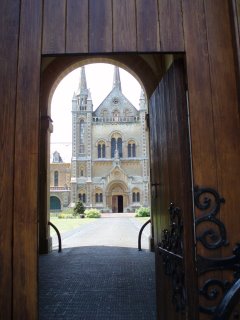Parkminster pics
Here is the front entrance to St Hugh's Charterhouse at Parkminster.

Through the door, there is a view of the smaller cloister and the entrance to the Great Cloister.

 On the right of the front entrance is a statue of St Bruno, the founder of the Carthusians.
On the right of the front entrance is a statue of St Bruno, the founder of the Carthusians.
Today, we finished the Sacrament of Confirmation, looking at the historically convoluted question of the minister of the sacament. We then moved on to the Eucharist in the scriptures, looking at the Old Testament types and then the fascinating and highly significant analysis of the Last Supper by Joachim Jeremias. Briefly, he argues that the Last Supper was indeed a Passover Meal. (This accords with the synoptic accounts but not with St John.) If it was a Passover Meal, then everything about it was ritualised with special food, the participants adopting a special posture (reclining as free people rather than standing as slaves), and a particular form of words. The paterfamilias normally took the bread and said "This is the bread of affliction" referring to the affliction of the people in Egypt from which they were freed that night.
Jesus instead took the bread and said "This is my body".

Through the door, there is a view of the smaller cloister and the entrance to the Great Cloister.

 On the right of the front entrance is a statue of St Bruno, the founder of the Carthusians.
On the right of the front entrance is a statue of St Bruno, the founder of the Carthusians. Today, we finished the Sacrament of Confirmation, looking at the historically convoluted question of the minister of the sacament. We then moved on to the Eucharist in the scriptures, looking at the Old Testament types and then the fascinating and highly significant analysis of the Last Supper by Joachim Jeremias. Briefly, he argues that the Last Supper was indeed a Passover Meal. (This accords with the synoptic accounts but not with St John.) If it was a Passover Meal, then everything about it was ritualised with special food, the participants adopting a special posture (reclining as free people rather than standing as slaves), and a particular form of words. The paterfamilias normally took the bread and said "This is the bread of affliction" referring to the affliction of the people in Egypt from which they were freed that night.
Jesus instead took the bread and said "This is my body".
